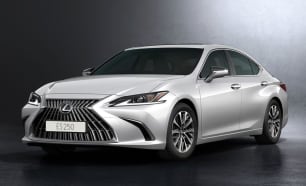The existing ES 300h (the ‘h’ denoting hybrid) is now joined by a non-hybrid model using the same petrol engine, tuned specifically to run without the support of an electric motor.
The pre-update, hybrid-only ES line-up spanned six model variations across a roughly $15K price spread from the ES 300h Luxury ($62,525) to the ES 300h Sports Luxury ($77,000).
Now there are five models with an ‘Enhancement Pack’ (EP) available on three of them, for an effective range of eight grades. Again, it's a $15K spread, stretching from the ES 250 Luxury ($61,620, before on-road costs) to the ES 300h Sports Luxury ($76,530).
Let's kick-off with the ES 250 Luxury. Aside from the safety and powertrain tech covered later in the review, the ‘entry-level’ grade is loaded with standard features including, 10-way power-adjustable and heated front seats, dual-zone climate control air, active cruise control, a new 12.3-inch multimedia touchscreen, satellite navigation (with voice control), keyless entry and start, 17-inch alloy wheels, a glass sunroof, auto rain-sensing wipers, plus 10-speaker audio with digital radio, as well as Apple CarPlay and Android Auto compatibility. The steering wheel and gearshift are leather-trimmed, while the seat trim is synthetic leather.
An Enhancement Pack adds wireless phone charging, privacy glass, a colour head-up display, and $1500 to the price tag (total $63,120).
The next rung up the price ladder brings the hybrid powertrain into play, so the ES 300h Luxury ($63,550) retains all the features of the ES 250 Luxury EP and adds a rear spoiler and power adjustable steering column.
Opting for the ES 300h Luxury EP then adds a power boot lid (with kick sensor), leather-accented trim, 18-inch rims, panoramic view monitor (overhead and 360-degree), 14-way power driver's seat (with memory settings), ventilated front seats, side blinds and a power rear sunshade, as well as $8260 to the price (total $71,810).
Next, as the name implies, two ES F Sport models dial up the performance personality.
The ES 250 F Sport ($70,860) retains the features of the ES 300h Luxury EP (except side blinds) while adding LED headlights with adaptive high-beam, a ‘wire-mesh’ grille, sports body kit, 19-inch wheels, performance dampers, an 8.0-inch driver display, alloy interior accents and grippier F Sport seats.
Stump up for the ES 300h F Sport ($72,930) and you'll ride on an adaptive suspension system with two driver-selectable settings, Go one step further and select the ES 300h F Sport EP ($76,530) and you'll also be cranking up a 17-speaker Mark Levinson audio system and warming your hands on a heated steering wheel.
Then, the top-of-the ES pyramid, the 300h Sports Luxury ($78,180), puts it all on the table adding top-shelf semi-aniline leather-accented trim, power adjustable, reclining, and heated rear outboard seats, tri-zone climate control, as well as side door blinds and a power rear sunshade. The rear centre armrest also features controls for the sunshade, seat heating (and angle), as well as audio and climate settings.
That's a lot to take in, so here's a table to help clarify the model walk-up. But suffice it to say this ES maintains Lexus’ reputation for value, testing its competitors in the luxury sedan space.

